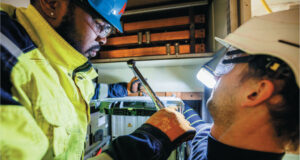Here is area where many facilities struggle. Incorrectly installed and/or adjusted pump packing is a major source of reliability problems in industry.
When packing leaks excessively it directly affects machine life by contaminating bearings with water or product. It damages and corrodes the machine bases, which in turn leads to alignment problems. It makes it very hard to maintain even rudimentary housekeeping standards, which leads to many other issues. Poorly adjusted packing leads to over tightening of the gland and the inevitable shaft damage that results.
So how do we get control of our pump packing?
- Align the machines
a. Packing is no more forgiving than any other sealing system when it comes to misalignment. Shaft deflection from misalignment will damage the packing. - Use the correct size packing
a. We are often tempted to use oversize packing to try to compensate for shaft/sleeve/stuffing box wear. DON’T it just makes it worse.
it worse. - Inspect the shaft/Sleeve/Stuffing box
a. Any wear, corrosion or damage will destroy new packing almost immediately
b. Any more than 1/32” (0.8mm) wear should be flagged and changed. - Pay attention to the throat bushing clearance
a. The throat bushing supports the bull ring and prevents extrusion. More importantly it regulates the flow of flush and maintains the back pressure in the stuffing box.
- Use good installation techniques
a. Validate the correct packing size by measuring the stuffing box diameter, subtracting the shaft diameter and dividing by 2
b. Validate the correct number of turns by dividing the stuffing box depth by the size of the packing (don’t forget to subtract 1 for lantern ring)
c. Cut packing correctly,
d. Make sure the lantern ring is positioned correctly. - Initial Adjustment
a. Most packing is destroyed during the first adjustment.
b. Adjusting new packing for the first time is time consuming (up to 45 mins)
c. Continually monitor gland and stuffing box temperature during initial adjustment. Any (even slight) increase in temperature is an indication there may be a problem. Back off and let the temperature settle.
d. No more that 3 flats of adjustment at 1 time. - On-going Adjustment

a. Properly adjusted packing should leak 10-15 drops per min. It has to in order to lubricate. Packing should be checked daily and adjusted as needed. - Seal Flush
a. Make sure that the seal water supply is clean, and reliable… unlike mechanical seals just a few minutes without seal water will destroy packing. - Temporary Fixes
a. There are many “wonder products” on the market today. Some make performance claims that are somewhat optimistic. Many of them can be used as a temporary fix until a proper repair can be made, but should not be considered a permanent solution.
From Tim Dunton, Reliability Solutions.
 Paper 360
Paper 360

